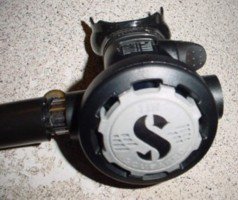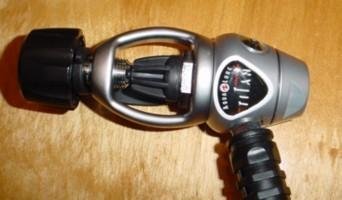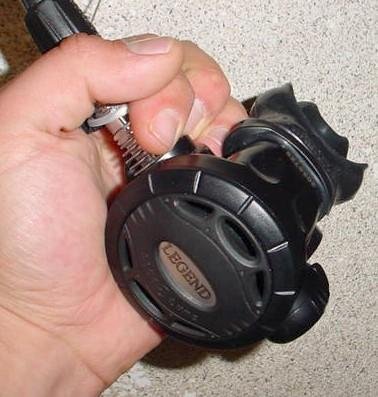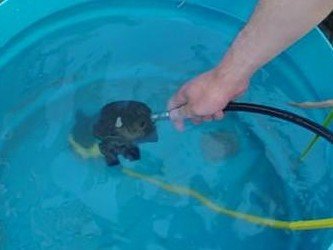Regulators
Modern scuba diving was born with the invention of the regulator. This is the piece of equipment that delivers air to the diver, and while they may appear complicated, it's their simplicity that makes them safe and dependable.
Additional equipment is attached to the regulator to increase safety. These include gauges that provide important information as well as an alternate air source that allows you to share air with your buddy in the event of an out-of-air emergency.

First Stage
Regulators consist of two components. These are the 1st and 2nd stages.
As you learned during the "Scuba Cylinders" lesson, the pressure inside your cylinder can be as high as 3500 psi. Before you breathe this air the pressure must be reduced to a safe level. So the function of the 1st stage is to reduce the pressure to about 140 psi.
The 1st stage connects directly to your cylinder's valve, and threaded ports allow you to attach air hoses for the 2nd stage, BCD power inflator, and alternate air source. One of these ports is labeled "HP" (high pressure) because the air pressure delivered through this port is not reduced by the 1st stage. This port is used to attach the submersible pressure gauge, which indicates the cylinder's pressure while you dive.

Second Stage
The 2nd stage is the component you hold in your mouth, and delivers air on demand when you breathe. When you inhale, a flexible diaphragm is pulled in which opens the 2nd stage's valve. The valve closes when you stop inhaling. When you exhale, the air exits through one-way valves located underneath the mouthpiece.
The 2nd stage delivers air at ambient pressure, or the pressure equivalent to your surrounding pressure. This means that no matter how deep you are diving, the regulator provides the amount of air you need to breathe.
The front of the 2nd stage has a button that pushes in on the diaphragm. This allows you to clear the 2nd stage in the event it fills with water. Your instructor will teach you how to clear the regulator during your pool sessions.

Reliability and Safety
One of the greatest fears new divers face is the thought of an equipment malfunction cutting off air delivery. Rest assured that modern regulators are designed to prevent this from occurring.
The regulator's valves are designed to deliver unrestricted airflow in the event of failure. This condition is called a free-flow because a constant flow of air escapes from the regulator. Failures are rare, but you'll still be able to breathe from the regulator on your way to the surface.
Your regulator may also free-flow when it's out of your mouth and the mouthpiece is pointing up. If this occurs, turn the 2nd stage so the mouthpiece points down, and the free-flow will stop. You'll lose air while the regulator free-flows, so when taking the regulator out of your mouth, make sure the mouthpiece is pointing down.
Selecting A Regulator
The most important considerations when selecting a regulator are comfort and ease of breathing.
You'll be holding the regulator in your mouth while diving, so choose a regulator that fits comfortably. The weight of the 2nd stage and design of the mouthpiece are two factors that affect comfort.
All regulators sold by reputable dive shops are suitable for diving but differ in their ease of breathing. When possible, try the regulator before you purchase it to ensure it breathes easily and with minimal effort.
High performance regulators are available for divers who plan on diving deep. These regulators have higher airflow rates to compensate for the increased density of air at deeper depths.
Rinsing and Storing Your Regulator
You should rinse your regulator and gauges with fresh water at the end of each diving day. It's recommended you soak the regulator overnight to dissolve all salt crystals, followed by a fresh water rinse before storage.
When rinsing the regulator you must take special precautions to prevent water from entering the hoses and 1st stage. Make sure the dust cap is installed before immersing the regulator in water. The dust cap seals against the 1st stage's air inlet and protects the regulator from water and dirt. Also, never press the purge button when rinsing the regulator. Doing so allows water to enter the air hose and eventually the 1st stage.
Store the regulator carefully to avoid damaging the hoses. Tight coils and kinks stress the hoses and cause cracking.


Regulator Service & Inspections
Your regulator should be serviced annually by an authorized technician. During the annual service your regulator is disassembled and cleaned, parts are replaced, and adjustments are made. During this time you should also request that your gauges be tested for accuracy.
